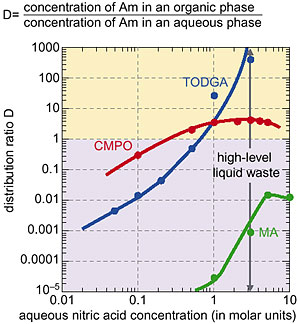 |
||
|
 |
||
|
| Radioactive liquid waste discharged from the reprocessing of spent nuclear fuels contains, in addition to fission products (FP), long-lived actinide elements An. To reduce the burden on the environment imposed by the disposal of radioactive waste, it is desirable to separate the An elements from the FP. Tributylphosphate (TBP) has been used successfully in reprocessing to separate U(VI) and Pu(IV) from FP. However, it is ineffective for extractive separation of such less-reactive trivalent and pentavalent An ions as americi-um, Am(III), curium, Cm(III), and neptunium, Np(V). Therefore, development of a new extractant which shows stronger bonding to these ions is required. For such a new extractant the following characteristics are essential: (1) It must extract actinides from a nitric acid solution into an organic phase with high efficiency; (2) its solubility in n-dodecane (a diluent) must be high, and (3) from the standpoint of waste disposal, it must undergo complete incineration into only gaseous substances (including water). In order to develop a new extractant which satisfies the foregoing three conditions, we selected a malonamide MA as a starting material (Fig. 6-1). The MA, however, does not adequately fulfill the condition (1) as Fig. 6-2 shows. This drawback has to be improved. First, we tried to introduce an additional oxygen atom into the MA molecule, because it is known that oxygen atoms in the extractant molecule can usually bond with actinide ions. An ether oxygen atom was introduced into several positions in the molecule, and the performance of the resulting molecule was examined. EXAFS analysis revealed the result that when an etheric oxygen atom is introduced between the two carbonyl groups (C=O), the oxygen atom coordinates with the An in liaison with the oxygen atoms of the two carbonyl groups. Thus, a very stable compound (complex) is formed through the bonding of the extractant with the actinides. For the second step, the relationship between the extraction efficiency and the lipophilicity of the extractant was examined by changing the length of the carbon chains located at both ends of the molecule. Eventually, the octyl group was found to be the best. Thus, by designing the appropriate molecule as described above, we have succeeded in developing a new extractant with high extraction efficiency for the An elements: N,N,N',N'-tetraoctyl-3-oxapentane-1,5-diamide (abbreviated as Tetraoctyldiglycol-amide or TODGA). In Figure 6-2, the performance of TODGA is compared with existing extractants, such as CMPO and MA. In nitric acid concentrations above 1 M, the new extractant TODGA shows an extraction efficiency for Am(III) which is much higher than the already-known extractants, demonstrating that it is an excellent extractant for the actinides. |
| Reference Y. Sasaki et al., The Novel Extractants, Diglycolamides, for the Extraction of Lanthanides and Actinides in HNO3 -N-Dodecane System, Solv. Extr. Ion Exch., 19(1), 91 (2001). |
| Select a topic in left column |  |
| Persistent Quest - Research Activities 2001 Copyright(c) Japan Atomic Energy Research Institute |